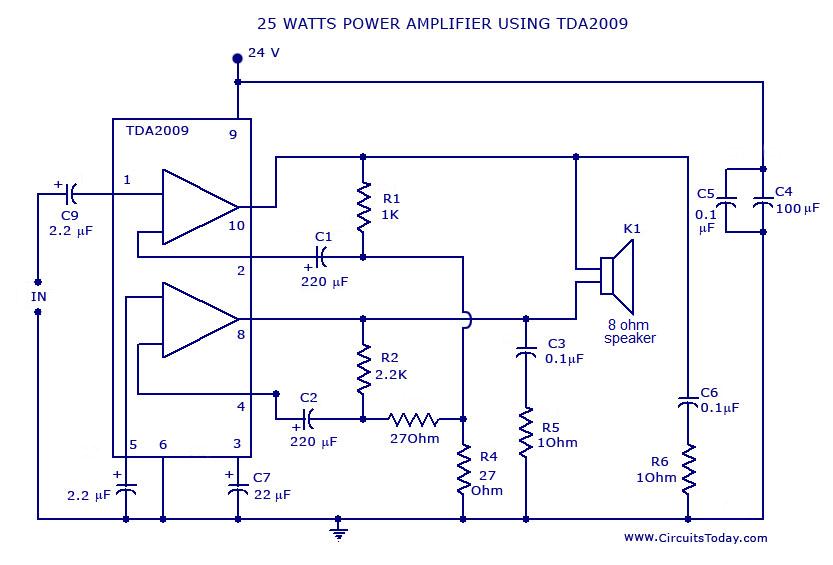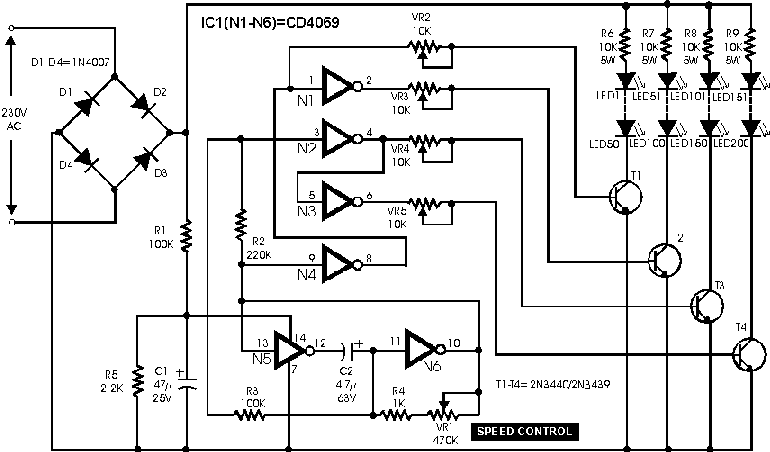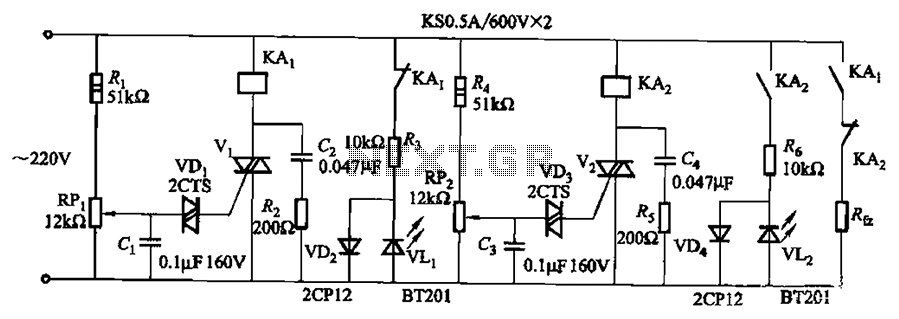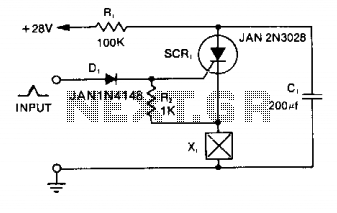
Decibels Meter Circuit Using LM324
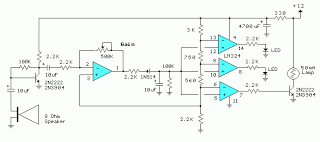
This decibel meter circuit responds to sound pressure levels ranging from approximately 60 to 70 dB (decibels). The sound is captured by an 8-ohm speaker and amplified using a transistor stage along with an LM324 operational amplifier section. A dynamic microphone can serve as the audio signal input source; however, a small speaker is more sensitive. The remaining three sections of the LM324 quad op-amp are utilized as voltage comparators, driving three indicator LEDs or incandescent bulbs spaced about 3 dB apart. An additional transistor is required for the incandescent lights, as indicated with the lower lamp. The circuit employs 12-volt, 50 mA lamps, with each light representing approximately a 3 dB change in sound level. Consequently, when all three lights are illuminated, the sound level is roughly four times greater than the level needed to activate one lamp. Sensitivity can be adjusted using a 500K potentiometer, allowing one lamp to illuminate at a reference sound level, while the other two lamps indicate approximately 2X and 4X increases in volume. In operation, with no input, the DC voltage at pins 1, 2, and 3 of the op-amp is about 4 volts. The voltage at the positive inputs of the three comparators (pins 5, 10, 12) is approximately half a volt less due to the 1N914 diode drop. The voltage on the negative comparator inputs is around 5.1 and 6.5, set by the 560-ohm and 750-ohm resistors. When an audio signal is present, the 10 µF capacitor connected to the diode charges toward the peak audio level at the op-amp output at pin 1. As the volume increases, the DC voltage on the capacitor and the positive comparator inputs rises, causing the lamp to turn on when the positive input exceeds the negative input. Conversely, as the volume decreases, the capacitor discharges through a parallel 100K resistor, causing the lamps to extinguish. The response time can be adjusted with a larger or smaller capacitor. This decibel meter circuit requires a well-filtered power source, as it is sensitive to small changes in supply voltage; therefore, a large filter capacitor should be connected directly to the 330-ohm resistor. The circuit has been successfully operated with an unregulated wall transformer power source using a 4700 µF capacitor. It also functions effectively on a regulated supply with only a 1000 µF capacitor.
The decibel meter circuit is designed to provide a visual indication of sound levels, making it useful for various audio applications. The core components include an 8-ohm speaker, which acts as a sound sensor, and the LM324 operational amplifier, which amplifies the detected audio signal. The circuit's sensitivity is adjustable, allowing for calibration based on the specific environment or application.
The use of voltage comparators within the LM324 allows for a straightforward method of determining sound level thresholds. As sound levels fluctuate, the capacitive coupling ensures that the circuit responds dynamically, charging and discharging to reflect changes in volume. The inclusion of indicator lamps provides immediate feedback, facilitating quick visual assessment of sound levels.
For optimal performance, the power supply must be stable and well-filtered. This is critical as fluctuations in supply voltage can lead to inaccurate readings. The specified filter capacitor values ensure that the circuit operates reliably, mitigating the effects of noise and ripple from the power source.
Overall, the decibel meter circuit is an effective tool for monitoring sound levels, suitable for use in environments where sound pressure levels need to be controlled or analyzed. Its design allows for flexibility in application, with the potential for further modifications to enhance functionality or adapt to specific user requirements.This decibels meter circuit responds for sound pressure levels from about 60-70 dB(Decibels). That sound is picked up by an 8 ohm speaker, amplified with a transistors stage and LM324 op-amp section. For audio signal input source, a dynamic microphone can be used but a small speaker was more sensitive.
The remaining three sections of the IC LM324 quad op-amp are used as volts comparators and drive three indicator LEDs or incandescents which are spaced about 3dB apart. An additional transistor is needed for incandescent lights as shown with the lower lamp. I used 12 volt, 50mA lamps. Each light represents about a 3dB change in sound level so that when all 3 lights are on, the sound level is about 4 times greater than the level needed to light one lamp.
The sensitivity can be adjusted with the 500K pot so that one lamp comes on with a reference sound level. The other two lamps will then indicate about a 2X and 4X increase in volume. In operation, with no input, the DC voltage at pins 1, 2 and 3 of the op-amp will be about 4 volts, and the voltage on the (+) inputs to the 3 comparators (pins 5, 10, 12) will be about a half volt less due to the 1N914 diode drop.
The voltage on the (-) comparator inputs will be around 5. 1 and 6. 5 which is set by the 560 and 750 ohm resistors. When an audio signal is present, the 10uF capacitor connected to the diode will charge toward the peak audio level at the op-amp output at pin 1. As the volume increases, the DC voltage on the capacitor and also (+) comparator inputs will increase and the lamp will turn on when the (+) input goes above the (-) input.
As the volume decreases, the capacitor discharges through the parallel 100K resistor and the lamps go out. You can change the response time with a larger or smaller capacitor. This decibels meter circuit requires a well filtered power source, it will respond to very small changes in supply voltage, so you probably will need a large filter capacitor connected directly to the 330 ohm resistor.
I managed to get it to work with an unregulated wall transformer power source, but I had to use 4700uF. It worked well on a regulated supply with only 1000uF. 🔗 External reference
The decibel meter circuit is designed to provide a visual indication of sound levels, making it useful for various audio applications. The core components include an 8-ohm speaker, which acts as a sound sensor, and the LM324 operational amplifier, which amplifies the detected audio signal. The circuit's sensitivity is adjustable, allowing for calibration based on the specific environment or application.
The use of voltage comparators within the LM324 allows for a straightforward method of determining sound level thresholds. As sound levels fluctuate, the capacitive coupling ensures that the circuit responds dynamically, charging and discharging to reflect changes in volume. The inclusion of indicator lamps provides immediate feedback, facilitating quick visual assessment of sound levels.
For optimal performance, the power supply must be stable and well-filtered. This is critical as fluctuations in supply voltage can lead to inaccurate readings. The specified filter capacitor values ensure that the circuit operates reliably, mitigating the effects of noise and ripple from the power source.
Overall, the decibel meter circuit is an effective tool for monitoring sound levels, suitable for use in environments where sound pressure levels need to be controlled or analyzed. Its design allows for flexibility in application, with the potential for further modifications to enhance functionality or adapt to specific user requirements.This decibels meter circuit responds for sound pressure levels from about 60-70 dB(Decibels). That sound is picked up by an 8 ohm speaker, amplified with a transistors stage and LM324 op-amp section. For audio signal input source, a dynamic microphone can be used but a small speaker was more sensitive.
The remaining three sections of the IC LM324 quad op-amp are used as volts comparators and drive three indicator LEDs or incandescents which are spaced about 3dB apart. An additional transistor is needed for incandescent lights as shown with the lower lamp. I used 12 volt, 50mA lamps. Each light represents about a 3dB change in sound level so that when all 3 lights are on, the sound level is about 4 times greater than the level needed to light one lamp.
The sensitivity can be adjusted with the 500K pot so that one lamp comes on with a reference sound level. The other two lamps will then indicate about a 2X and 4X increase in volume. In operation, with no input, the DC voltage at pins 1, 2 and 3 of the op-amp will be about 4 volts, and the voltage on the (+) inputs to the 3 comparators (pins 5, 10, 12) will be about a half volt less due to the 1N914 diode drop.
The voltage on the (-) comparator inputs will be around 5. 1 and 6. 5 which is set by the 560 and 750 ohm resistors. When an audio signal is present, the 10uF capacitor connected to the diode will charge toward the peak audio level at the op-amp output at pin 1. As the volume increases, the DC voltage on the capacitor and also (+) comparator inputs will increase and the lamp will turn on when the (+) input goes above the (-) input.
As the volume decreases, the capacitor discharges through the parallel 100K resistor and the lamps go out. You can change the response time with a larger or smaller capacitor. This decibels meter circuit requires a well filtered power source, it will respond to very small changes in supply voltage, so you probably will need a large filter capacitor connected directly to the 330 ohm resistor.
I managed to get it to work with an unregulated wall transformer power source, but I had to use 4700uF. It worked well on a regulated supply with only 1000uF. 🔗 External reference

